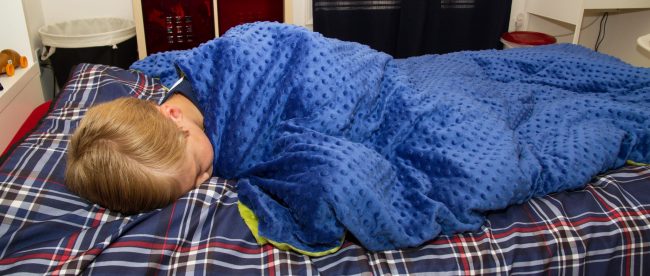Harkla Weighted Blanket For Autism, Anxiety Or ADHD
Weighted blankets have been used for quite a while in the world of special needs and anxiety disorders. However, they are starting to become popular outside of those realms and more in a day-to-day stress and sleep aid.
When looking for solutions to normal stress and struggle sleeping, more people are turning to weighted blankets for help. The added weight of the blankets helps release the chemical serotonin in the body, which helps create a feeling of calm and relaxation. On top of that, serotonin is necessary for the body to make melatonin, which is a chemical which helps regulate the body’s sleep schedule.
The science behind why weighted blankets work is called Deep Touch Pressure (DTP). DTP has been studied in various ways, including weighted blankets, weighted vests, and even massages. Anything that gives a gentle pressure on the body without hurting can fall under DTP.
If you think a weighted blanket could help you or someone you love, then you’ll enjoy the infographic below. It covers more about why weighted blankets work, what to expect when purchasing one, and who to choose the right one.
If you have any questions or comments about weighted blankets, please feel free to ask them in the comments!
This infographic originally appeared on Harkla.co. Text description of this infographic is right below it.
Could you benefit from a weighted blanket?
What is a weighted blanket?
Weighted blankets are exactly what they sound like – regular blankets with extra weight added to them!
Weighted blankets can come in various shapes and sizes and can be made from a variety of fabrics and fillers.
Fabric: Cotton, Flannel, Minky
Filling: Plastic Pellets, Glass Beads, Rice/Barley
Who can use one?
Weighted blankets are for a wide range of people, but can have a big impact for those with:
(all stats will be from USA)
- Sleep Disorders – 60 million
- Anxiety Disorder – 40 million
- ADHD – Attention -Deficit/Hyperactivity Disorder – 6.4 million
- Sensory Processing Disorder – 3.7 million
- Autism Spectrum Disorder – 3.5 illion
What do these all have in common?
Low serotonin & active nervous systems. However, weighted blankets are a great option for those who deal with daily normal stress!
How Do Weighted Blankets Work?
The underlying science of weighted blankets are:
Deep Touch Pressure (DTP)
Deep Touch Pressure is gentle pressure evenly distributed on the body. It can be accomplished by:
- Hugs
- Massages
- Weighted Compression Vests
- Weighted Blankets
What does Deep Touch Pressure do?
1. Increases the release of Serotonin: Serotonin is a chemical in the body that plays a key role in:
- Sensory Gating and Processing
- Behavior Inhibition
- Appetite
- Aggression
- Sleep
- Mood
- Brain Development
Serotonin is also a necessary building block for melatonin. Melatonin is important for healthy sleep.
2. Reduces Nervous System Activity
What Are The Benefits of Weighted Blankets?
There are three major benefits of weighted blankets:
1. Reduces Anxiety: Whether it’s anxiety from autism, ADHD, PTSD, or an anxiety disorder.
2. Improves Sleep
- Faster to fall asleep
- Reduces anxiety
- Deeper sleep
- Less movement during the night
3. Improve Focus in Classroom
-
- “ADHD improved 18 to 25% with on-task behavior while utilizing Deep Touch Pressure.”
- Occupational therapists see the most improvement from deep touch pressure when it comes to staying on task, staying in seat and attention span.
How to Choose the Right Weighted Blanket for Yourself
To get the full benefits of a weighted blanket, it’s important to select a blanket that has the right amount of weight for you.
General Rule of Thumb: 10% of your bodyweight + 1-2 lbs
For example: A child that weights 50 lbs would be best suited with a 6-7 lb weighted blanket.
Sizing Chart *
| Body Weight | Estimated Age (Years) | Blanket Weight |
| 30-40 | 2-5 | 5 lbs |
| 50-60 | 7-9 | 7 lbs |
| 70-80 | 10-11 | 9 lbs |
| 90-100 | 12-13 | 11 lbs |
| 110-120 | 14-15 | 13 lbs |
| 130-140 | 16-17 | 15 lbs |
| 150-160 | 19-21 | 17 lbs |
| 170 | 21 | 20 lbs |
*However, choosing the right weighted blanket is also a matter of preference. Someone may feel more comfortable with a blanket that is heavier or lighter than the recommended range.
Sources:
- Http://www.healthcommunities.com/sleep-disorders/overview-of-sleep-disorders.shtml
- https://www.adaa.org/about-adaa/press-room/facts-statistics
- http://healthline.com/health/adhd/facts-statistics-infographic
- http://www.sensory-processing-disroder.com/statistics.html
- https://www.bloomberg.com/news/articles/2014-06-09/autism-costs-more-than-2-million-over-patient-s-life
- http://www.tandfonline.com/doi/full/10.1080/00207450590956459?src=recsys
- http://www.sciencedirect.com/science/article/pii/S0273229711000025
- http://jmbe.bme.ncku.edu.tw/files/1961/public/1961-5094-1-PB.pdf
- http://www.tandfonline.com/doi/abs/10.1300/J004v24n01_05
- http://www.ziboathene.dk/wp-content/uploads/G.BAdre_.ResearchArticle/2015.pdf
- http://ajot.aota.org/article.aspx?articleID=2247281
- http://foa.sagepub.com/content/24/1/17.short
- http://fileserver.daemen.edu/~rholmstrweighted_vest_and_adhd.pdf
- http://www.tandfonline.com/doi/abs/10.1300/J006v24n03_04
[Thank you, Casey Ames, owner of Harkla, for sharing this infographic!]



Can you buy replacement covers for the Harlan blanket?
Hi Donna,
Yes, you can purchase a replacement cover. Here is the link: https://harkla.co/products/harkla-weighted-blanket-cover
Have a great week!